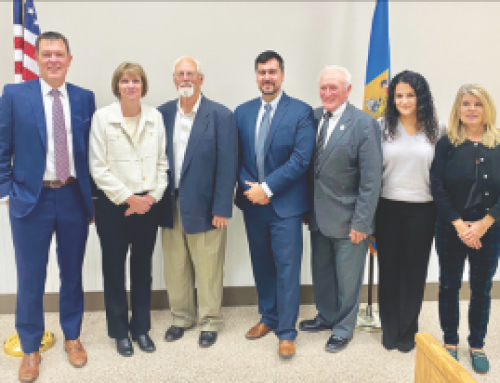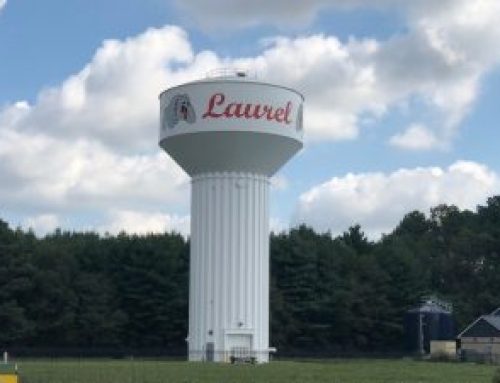Rosemont was home to Nathaniel Mitchell, 16th governor of Delaware
Earlier this year, Ned Fowler was looking through an attached shed at Rosemont, the 18th-century home at the corner of Delaware and Maryland avenues in Laurel. The property had been purchased by the Laurel Redevelopment Corporation and Fowler and other members of the Laurel Historical Society had been invited in to look through the contents.
Stored in the shed were gardening and yard implements, Fowler said. And then, “hanging from nails on the wall, I saw these four green Windsor side chairs,” he said. “I thought, ‘Can they be, can they really be?’”

Volunteers gather on the front porch of Rosemont after a day of work cleaning up the grounds. Photo by Paula Shannon
It turned out that the chairs are from the early 19th century, “1830s or so,” Fowler said. The historical society has a photograph of Rosemont, taken in 1904, that shows the chairs sitting on the front porch.
Just last week, volunteers with the historical society found a complete set of paneling that had surrounded a fireplace in the Rosemont parlor. The paneling, as well as some raised-panel shutters that are original to the house, were stored on top of the rafters in the garage.
“This is 18th-century woodwork we are talking about,” Fowler said. “It is very exciting.”
Rosemont is Laurel’s “oldest and most significant property,” said Brian Shannon, executive director for the Laurel Redevelopment Corporation (LRC). “Laurel had its beginnings right there,” along Broad Creek and at the mill that used to be there, “and it’s important to preserve that as much as possible.”
The LRC, in consultation with the historical society, is figuring out how to use Rosemont, Shannon said. “We’ve come up with a number of ideas, none of which we want to go public with at this point,” he added. “But we feel it could very well lend itself toward having some community use.”
On Saturday, about 40 volunteers, including members of the Laurel High School basketball team, worked on the grounds of Rosemont, cleaning up brush and pruning trees and shrubbery. One objective of the historical society is community outreach, President George Denney said, and “this is meeting that goal.”
The structure itself appears to be sound, Fowler said, but needs attention, including replacing rotten pillars on the front porch and updating electrical and plumbing systems.
The house was most recently occupied by Kathleen Tissian, who died May 28, 2019. The LRC purchased it and the 1.7 acres on which it sits from Tissian’s heirs in April for $125,000. Included in the purchase were all of the contents of the house, items that had belonged to the four families that have lived there.
The exact date of construction of Rosemont is not known. Some sources say it was built in 1767, but Fowler said that that is not certain.
“That date is quite possible, but we can’t say that with assurance,” he said. What is certain, he added, is that it was built in the second half of the 18th century.
A notable history- Rosemont was originally in the hands of the Mitchell family. Nathaniel Mitchell, who served as governor of Delaware from January 1805 to January 1808, was the fourth person in that family to own the property, Fowler said.
Mitchell was an officer during the American Revolution and was at Valley Forge with George Washington in the winter of 1778. He was one of 37 Continental Army officers who were members of Delaware’s chapter of the Society of the Cincinnati, founded in 1783. (The society, which still exists and which calls itself the nation’s oldest patriotic organization, had George Washington as its first president.) In addition, he served in the Continental Congress in 1787 and 1788 after being elected as a delegate in October 1786.
After his term as governor, Mitchell served in the state House of Representatives and then in the state Senate. He died Feb. 21, 1814, and is buried in the cemetery at Old Christ Church east of Laurel.
Meshack Elliott bought Rosemont from the Mitchell family in 1837. Like the Mitchells, the Elliotts were a wealthy family, owning thousands of acres of land as well as “tents” at the Methodist camps near Laurel and in Rehoboth.
Mary Ann Elliott Collins inherited the house following the death of her father, Meshack, in 1856 and her mother, Margaret, in 1867. Mary Ann’s husband was Theophilus Collins, whose father, John, also served as governor.
After Theophilus’ death in 1858, Mary Ann moved from their home at Collins Pond east of Bridgeville back to Rosemont to live with her mother. When Mary Ann died in 1902, her son John inherited the house. His widow, Elizabeth Stevenson Collins, sold it at auction in 1953 to Milton and Beatrice Yerkes, whose daughters sold it in 2001 to Tissian.
Fowler said that preservation of Rosemont is important to the town for several reasons. Primary among them is its association with Nathaniel Mitchell. “Not every community can claim having such a notable resident, not just on a state level but on a national level,” he said. “He was really a big deal for around here.”
Second is the house itself, the only structure to survive from the earliest days of the town.
Third is Rosemont’s location, atop a hill overlooking the town. “People who lived there were the movers and shakers of what would become Laurel,” Fowler said. “They were the ones people in town looked up to.”
And finally is the fact that much of Laurel was built on land that was owned by the Mitchell and Elliott families.
“Laurel developed at Rosemont’s feet,” Fowler said. “It shares a place in our town’s history like no other property. It’s thanks to it and to the people who lived in it that we have our town today. And it’s time to repay the favor.”
To help out- Work to clean up the grounds of Rosemont continues. To volunteer to help, contact the Laurel Historical Society, 875-1344 or in**@***********************ty.org.
While it hasn’t started an official campaign to raise money for work at Rosemont, the Laurel Redevelopment Corporation is accepting donations, Director Brian Shannon said. The LRC recently became a 501(c)3 corporation, meaning that contributions are tax deductible. For information, call 875-0601.





